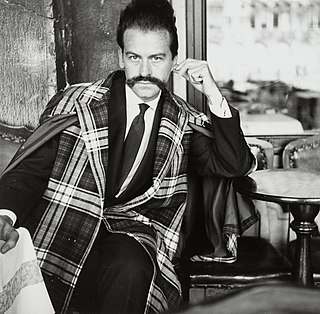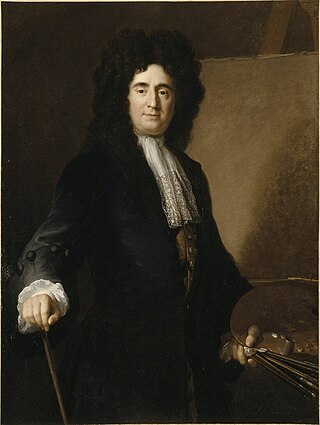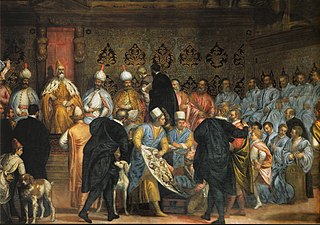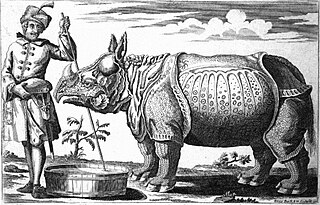
The Chorus is a 2004 French musical drama film directed by Christophe Barratier. Co-written by Barratier and Philippe Lopes-Curval, it is an adaptation of the 1945 film A Cage of Nightingales. The story is inspired by the origin of the boys' choir the Little Singers of Paris.

Claudio Coello was a Spanish Baroque painter. Coello is considered the last great Spanish painter of the 17th century.

The three Le Nain brothers were painters in 17th-century France: Antoine Le Nain (c.1600–1648), Louis Le Nain (c.1603–1648), and Mathieu Le Nain (1607–1677). They produced genre works, portraits and portrait miniatures.

Georges Mathieu was a French abstract painter, art theorist, and member of the Académie des Beaux-Arts in Paris. He is considered one of the fathers of European lyrical abstraction, a trend of informalism.

François de Troy was a French painter and engraver who became principal painter to King James II in exile at Saint-Germain-en-Laye and Director of the Académie Royale de peinture et de sculpture.

Carlo Cannovaro Caliari (1570–1596) was an Italian artist of the Renaissance period. He is also known as Carletto. The youngest son of Paolo Veronese, Caliari was active mainly in Venice, where he worked and inherited the studio of his far more famous father, and later worked along with his brother Gabriele and his uncle, Benedetto. His name is attached to several large pictures of banquets in Veronese's style. Alessandro Turchi worked briefly under him.
Kaspar Anton von Baroni-Cavalcabo or Gaspare Antonio Cavalcabò Baroni was an Italian painter in a late Baroque period and style. During the greater part of his life he lived in Sacco, where he died. Many of his drawings are in the Library at Innsbruck.

Michael Bryan was an English art historian, art dealer and connoisseur. He was involved in the purchase and resale of the great French Orleans Collection of art, selling it on to a British syndicate, and owned a fashionable art gallery in Savile Row, London. His book, Biographical and Critical Dictionary of Painters and Engravers, first published in 1813–1816, was a standard reference work throughout the 19th century, and was last republished in 1920; however it is now badly outdated.

Peter Angelis, variously recorded as Pieter Angellis, Pieter Anchillus, Pieter van Angellis or Pieter Angelles, was a painter active in Flanders, Germany, Italy, England and France.

Elias Baeck (1679–1747) called "Heldenmuth", was a German painter and engraver from Augsburg.

Joseph Louis Hippolyte Bellangé was a French battle painter and printmaker. His art was influenced by the wars of the first Napoleon, and while a youth, he produced several military drawings in lithography. He afterwards pursued his systematic studies under Gros, and with the exception of some portraits, devoted himself exclusively to battle-pieces. In 1824, he received a second class medal for a historical picture, and in 1834 the decoration of the Legion of Honour, of which Order he was made an officer in 1861. He also gained a prize at the Paris Universal Exhibition of 1855.

Arnold van Boonen was a Dutch portrait painter.

Jean-Baptiste Boyer, Marquis d'Éguilles (1650–1709) was a French aristocrat, lawyer, and engraver.
William Bradley (1801–1857) was an English portrait artist.

Michiel Carree or Carré was a Dutch Golden Age painter.

Lucas Cornelisz de Kock or Kunst (1495–1552) was a Dutch Renaissance painter active in the Tudor court.
Willem de Keyser or De Keysar was a Flemish artist.
Jan van Rijn or Jean de Reyn was born at Dunkirk about the year 1610, and went when he was young to Antwerp, where he became a student of van Dyck. Such was his progress under that master, that he was invited to accompany him to England, where he continued to assist him until the death of his illustrious instructor. He afterwards established himself in his native town, where he painted several admirable pictures for the churches, and was much employed as a portrait painter. His principal works for the churches at Dunkirk were the 'Death of the four Royal Martyrs,' for the church of St. Eloi; and the 'Baptism of Totila,' for the church of the English convent.
Roeland van Eynden was a Dutch painter. He was born at Nymegen in 1747, and died at Dordrecht in 1819. Like his brother he devoted but a portion of his time to painting, and is principally known by his works on art and artists, of which the most important is the Geschiedenis der Vaderlandsche Schilderkunst, written in conjunction with Van der Willigen, and published in 1816–1842.

Bryan Coquard is a French cyclist, who currently rides for UCI WorldTeam Cofidis. He was a silver medalist at the 2012 Summer Olympics in the Omnium.
















